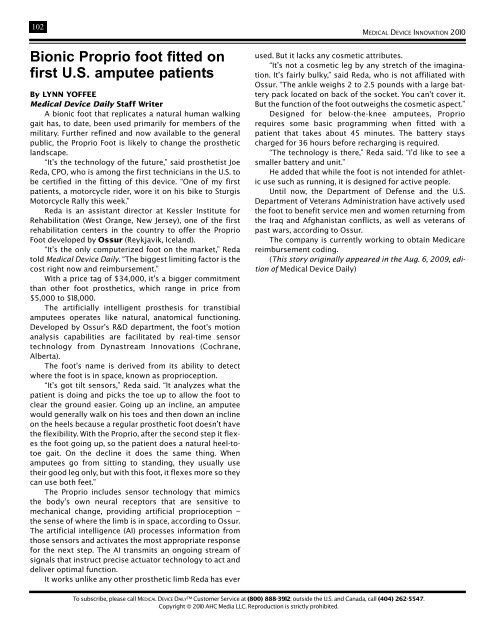MEDICAL DEVICE INNOVATION - Medical Device Daily
MEDICAL DEVICE INNOVATION - Medical Device Daily
MEDICAL DEVICE INNOVATION - Medical Device Daily
You also want an ePaper? Increase the reach of your titles
YUMPU automatically turns print PDFs into web optimized ePapers that Google loves.
102<br />
Bionic Proprio foot fitted on<br />
first U.S. amputee patients<br />
By LYNN YOFFEE<br />
<strong>Medical</strong> <strong>Device</strong> <strong>Daily</strong> Staff Writer<br />
A bionic foot that replicates a natural human walking<br />
gait has, to date, been used primarily for members of the<br />
military. Further refined and now available to the general<br />
public, the Proprio Foot is likely to change the prosthetic<br />
landscape.<br />
“It’s the technology of the future,” said prosthetist Joe<br />
Reda, CPO, who is among the first technicians in the U.S. to<br />
be certified in the fitting of this device. “One of my first<br />
patients, a motorcycle rider, wore it on his bike to Sturgis<br />
Motorcycle Rally this week.”<br />
Reda is an assistant director at Kessler Institute for<br />
Rehabilitation (West Orange, New Jersey), one of the first<br />
rehabilitation centers in the country to offer the Proprio<br />
Foot developed by Ossur (Reykjavik, Iceland).<br />
“It’s the only computerized foot on the market,” Reda<br />
told <strong>Medical</strong> <strong>Device</strong> <strong>Daily</strong>. “The biggest limiting factor is the<br />
cost right now and reimbursement.”<br />
With a price tag of $34,000, it’s a bigger commitment<br />
than other foot prosthetics, which range in price from<br />
$5,000 to $18,000.<br />
The artificially intelligent prosthesis for transtibial<br />
amputees operates like natural, anatomical functioning.<br />
Developed by Ossur’s R&D department, the foot’s motion<br />
analysis capabilities are facilitated by real-time sensor<br />
technology from Dynastream Innovations (Cochrane,<br />
Alberta).<br />
The foot’s name is derived from its ability to detect<br />
where the foot is in space, known as proprioception.<br />
“It’s got tilt sensors,” Reda said. “It analyzes what the<br />
patient is doing and picks the toe up to allow the foot to<br />
clear the ground easier. Going up an incline, an amputee<br />
would generally walk on his toes and then down an incline<br />
on the heels because a regular prosthetic foot doesn’t have<br />
the flexibility. With the Proprio, after the second step it flexes<br />
the foot going up, so the patient does a natural heel-totoe<br />
gait. On the decline it does the same thing. When<br />
amputees go from sitting to standing, they usually use<br />
their good leg only, but with this foot, it flexes more so they<br />
can use both feet.”<br />
The Proprio includes sensor technology that mimics<br />
the body’s own neural receptors that are sensitive to<br />
mechanical change, providing artificial proprioception –<br />
the sense of where the limb is in space, according to Ossur.<br />
The artificial intelligence (AI) processes information from<br />
those sensors and activates the most appropriate response<br />
for the next step. The AI transmits an ongoing stream of<br />
signals that instruct precise actuator technology to act and<br />
deliver optimal function.<br />
It works unlike any other prosthetic limb Reda has ever<br />
<strong>MEDICAL</strong> <strong>DEVICE</strong> <strong>INNOVATION</strong> 2010<br />
used. But it lacks any cosmetic attributes.<br />
“It’s not a cosmetic leg by any stretch of the imagination.<br />
It’s fairly bulky,” said Reda, who is not affiliated with<br />
Ossur. “The ankle weighs 2 to 2.5 pounds with a large battery<br />
pack located on back of the socket. You can’t cover it.<br />
But the function of the foot outweighs the cosmetic aspect.”<br />
Designed for below-the-knee amputees, Proprio<br />
requires some basic programming when fitted with a<br />
patient that takes about 45 minutes. The battery stays<br />
charged for 36 hours before recharging is required.<br />
“The technology is there,” Reda said. “I’d like to see a<br />
smaller battery and unit.”<br />
He added that while the foot is not intended for athletic<br />
use such as running, it is designed for active people.<br />
Until now, the Department of Defense and the U.S.<br />
Department of Veterans Administration have actively used<br />
the foot to benefit service men and women returning from<br />
the Iraq and Afghanistan conflicts, as well as veterans of<br />
past wars, according to Ossur.<br />
The company is currently working to obtain Medicare<br />
reimbursement coding.<br />
(This story originally appeared in the Aug. 6, 2009, edition<br />
of <strong>Medical</strong> <strong>Device</strong> <strong>Daily</strong>)<br />
To subscribe, please call <strong>MEDICAL</strong> <strong>DEVICE</strong> DAILY Customer Service at (800) 888-3912; outside the U.S. and Canada, call (404) 262-5547.<br />
Copyright © 2010 AHC Media LLC. Reproduction is strictly prohibited.
















